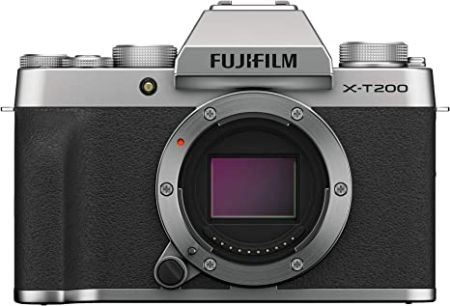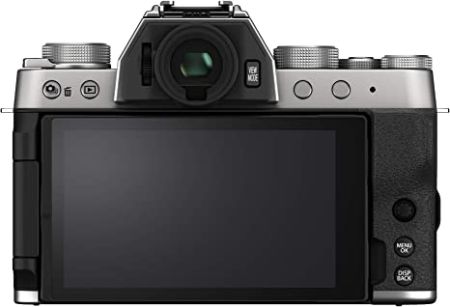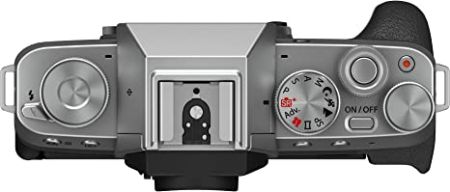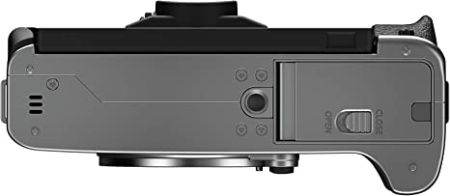The Fujifilm X-T200 is an enjoyable to-utilize mirrorless camera implied for the photographic artist who needs a passage-level camera with compatible focal points.
It’s speedy to center, takes great photographs and recordings, and with its next, each other sneak peeks of what a chosen channel will mean for a picture, and its assortment of scene presets, it is likewise a decent camera to assist novices with learning the nuts and bolts of photography, and we believe it to be one of the most mind-blowing cameras for fledglings.
Cost
The Fujifilm X-T200 is accessible for $699.95 with a 15-45mm focal point and is accessible in three tones (silver, dull silver, or champagne). Or on the other hand, you can get the body just for $599, which won’t burn through every last cent.
According to an exhibition viewpoint, it’s the equivalent of the viewfinder-less X-A7, yet shutterbugs will see the value in the EVF and somewhat more grounded control format. It’s not exactly a counterpart for the pricier X-T30, our Editors’ Choice in the mirrorless camera space, yet is a little less cash.
Camera Design
The Fujifilm X-T100, the X-T200 closely resembles a customary camera, with a metal cowl beating a body shrouded in pebbled dark skin and an SLR-type plan that places the viewfinder in the middle. A minimal 4.76 x 3.3 x 2.17 inches, it fits effectively in the hand, and at 13 ounces (counting the battery and memory card), is almost 3 ounces lighter than the X-T100.
The 3.5-inch 2,760K-speck LCD touchscreen takes up the vast majority of the rear of the X-T200. The left-side pivot opens the board 180 degrees (from forward to back confronting). Likewise, the screen pivots on a level plane through all points from zero to 270 degrees.
Both the pivot and the up/downturn move without a hitch, remaining solidly in anything position I put it – including different selfie sees. What shocked me was how neat the screen was at the point at which I was shooting outside, in everything except the most immediate daylight.

To one side of the LCD are two double capability buttons. The best one enacts the menu and chooses the ongoing choice featured on the screen. The base button flips among different presentation choices for shooting, as well as goes about as the back button for exploring the menus.
Simply over these buttons is a minuscule joystick that replaces the customary four-way rocker button for moving among the LCD’s choices and screens, as well as a fast change of the center moment that shooting. I found the joystick a pleasant expansion since I favor its positive material criticism contrasted with the rocker button, yet a few clients have revealed that it was excessively little for their fingers.
On the top is the focused viewfinder, with the popup streak and a hot-shoe simply above it. The shade button and video buttons are helpfully close to one another on the right. Tragically, the video button is very little and doesn’t give a lot of material criticism; I frequently needed to turn away from the viewfinder to be certain my finger was on it when I was prepared to record.
- High-quality images
- Decent webcam, podcasting, and family video
- Easy to use touchscreen with icons
- Sensitive
- Unsatisfactory battery life
- The sensor is not stable.
- Controls that are too small
Like most other Fujifilm cameras, the X-T200 has various fastens and dials that might be at first confounding to the new client. Also, many have double purposes, contingent upon what settings or capabilities you are utilizing. For example, encompassing the shade button is an ordered ring that you use to set the opening when in gap need mode, the screen speed when in shade need mode, and the blend of screen speed/gap when in program mode.
Behind the video, the button is another order dial. Its various capabilities incorporate utilizing it to page through tabs and pages when you’re in the menus. Or then again, while shooting, it will change openness pay.

I found the 0.39-inch, 2,368K-dab OLED variety viewfinder pleasantly responsive, turning on rapidly when I set my eye to it. It has a 0.62X amplification and quicker invigorating rate than the X-T100s. An openness remuneration (EV) scale shows obviously on the dark left line.
For serious videographers or vloggers, the X-T200 has an outer receiver 3.5mm jack. Earphones can be connected to the USB port, utilizing the provided USB-to-earphone jack converter.
On the off chance that you utilize a stand, you’ll find the situation of the memory card space in the battery compartment at the lower part of the camera to be a huge bother.
Ergonomics and Controls
The X-T200 shares a great deal of tech, and looks, with the X-A7, accessible for $100 less yet without a viewfinder. However, there are a few different contrasts. The X-T200’s wrap has a more unpleasant, rock finish, and a somewhat more profound handgrip. The general feel is somewhat more premium and gives more certainty if you anticipate matching it with a zooming focal point.
It has precisely the same optics as the XF 35mm F2 WR, yet drops climate security and a gap ring, and comes in at a portion of the cost.
There’s an inherent blaze, as well as a hot shoe for an outside strobe or remote trigger. The change to bust open the glimmer is at the left, settled under an adjustable control dial. The dial can serve quite a few capabilities — naturally, it burns through the in-camera film modes.

The Mode dial is simply to one side of the EVF and is flanked by front and back control dials. The screen discharge sits on the front dial. The shade position feels significantly better, however, the two dials are excessively thin — I wish they had a smidgen more level to them.
The Video Record button and On/Off balance the top controls. The Drive/Delete and Play buttons are on the back, over the LCD, and to one side of the eyecup. Toward its right, you’ll see the View Mode setting to flip the in-camera eye sensor alongside two programmable capability buttons.
Execution and speed
The X-T200 has various execution benefits over its ancestor, to a great extent because of the X-T200’s quicker, more remarkable copper-wire processor and Bayer design sensor. These incorporate quicker shooting speed for still pictures (8 casings each second versus 6 fps), better execution video (4K at 30P versus 4K at 15p), and self-adjust that is essentially as quick as the X-T3 (which was the first in class Fujifilm mirrorless camera at the hour of the X-T200’s delivery).
Different enhancements remember an increment for the moving shade from 1/fifteenth of one moment to a 1/30th of a subsequent which gives it 4K 30fps capacity. Self-adjust has 100 percent outline inclusion with 425 places of concentration, versus the T100’s 25% inclusion with just 91 places.
Like the first-in-class Fujifilm X-T3 and X-T4, the T200 utilizes half and half stage and difference identification self-adjust, exploiting the best of the two advances. Stage discovery gives a fast perusing of the topic. Contrast discovery can then finetune the center utilizing minute subtleties. In any case, because the sensor is quick, and the processor has the data transmission to perform multiple tasks, the camera can utilize both center frameworks without a moment’s delay and immediately consolidate their discoveries, to focus on the ideal subject concentration.
Power and Connectivity
The X-T200 is controlled by a similar FP-NW126S battery utilized by the vast majority of Fujifilm’s other mirrorless cameras. If you’re as of now putting resources into the framework, you could have a few extras around. Charging is finished in-camera, employing a USB-C association, so you can finish off through a versatile charger when in a hurry, or offer your PC or telephone charger while voyaging.
The camera is evaluated for around 270 shots for each charge or an hour and a half of video recording, however, picture playback, altering, and Wi-Fi move will bite into those figures. All things considered, it’s a low figure for this class, so I suggest conveying an extra battery or a power bank to finish it off during the day.

There’s a miniature HDMI port, so you can interface with a TV to play photographs and recordings for the family, or on the other hand, if you’re a high-level client, save the video to an outside recorder like the Atomos Ninja V. There’s likewise a 2.5mm association, so you can interface an outside mic with the right fitting connector, or a wired controller.
With the rendition 1.10 firmware update, Fujifilm has added a USB webcam backing to the X-T200. Once refreshed, you simply have to plug it into a PC or Mac PC framework through USB. It will appear in your accessible cameras list is viable programming — Google Meet, Microsoft Teams, Skype, and Zoom are upheld. The element is additionally accessible with the X-A7.
Photographs are saved to SDXC memory at up to UHS-I move rates. You can get them off the camera through USB or a card peruser, or interface with your cell phone to send photographs over Wi-Fi.
The Fujifilm Cam Remote application, a free download for Android or iOS, is required, and in-camera Bluetooth speeds up the association cycle, yet the actual exchanges can take some time — a solitary picture can require as long as twenty seconds to send. A portion of that time is given to begin the exchange, however, so moving shots in batches is valuable.
Picture quality
Similarly, as with the self-adjust framework, the X-T200’s imaging motor is fundamentally indistinguishable from the X-A7. It’s a standard Bayer variety channel sensor, as opposed to Fujifilm’s restrictive X-Trans.
Along these lines, a portion of the various modes accessible on better quality Fujifilm models, similar to the Eterna video profile and Classic Negative film look, aren’t accessible here, nor do you get grain reproduction or a portion of the more obscure handling choices, similar to the variety chrome hope to more readily protect detail is profoundly immersed subjects.
The sensor upholds ISO 200 (for brilliant light), as far as possible up to ISO 51200 for use while working in obscured insides. Picture quality drops as you move to the higher responsiveness, however on the off chance that you leave the camera set to programmed it won’t ever go above ISO 6400.
You’ll in any case appreciate excellent picture quality at that setting, with a touch of additional commotion and somewhat less detail than you see at ISO 200. The nature of JPGs drops perceptibly at ISO 12800 and deteriorates at the main 25600 and 51200 settings.
Final Thoughts
In the end, the Fujifilm X-T200 is a stronger performer than its predecessor, with a well-featured set of controls, good autofocus performance, and great image quality. It’s a camera we enjoy using for travel photography and for family outings; it’s also one that we’d recommend to enthusiast photographers who want a small mirrorless camera that can deliver in both still and video modes.
While it has flaws, the Fujifilm X-T200 is an enjoyable and capable camera for consumers who want a smaller system. It’s a lot of fun to use, and you should definitely give it a shot before you decide on your next mirrorless camera.









